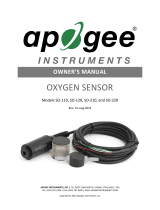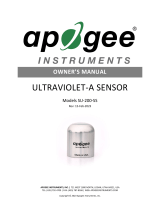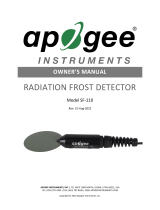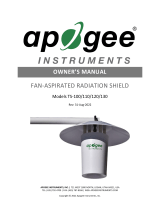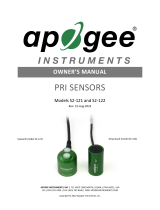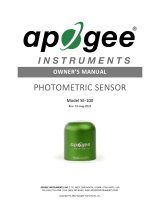INTRODUCTION
Oxygen (O2) is the second most abundant gas in the atmosphere and is essential to life on Earth. Oxygen
availability determines the rate of many biological and chemical processes and is required for aerobic respiration.
As described in this manual, it is the absolute amount of oxygen (measured as partial pressure in kilopascals) that
nearly always determines oxygen availability, but we think of oxygen as a percent of the total number of molecules
in the air (20.95 %). The best example of this is the oxygen on top of Mount Everest, which is 20.95 %, but most
climbers need supplemental oxygen to get to the top.
There are two types of oxygen sensors: those that measure gaseous O2 and those that measure dissolved oxygen
in a solution. The Apogee sensor measures gaseous O2.
There are multiple techniques for measuring gaseous oxygen. Three widely used approaches for environmental
applications are galvanic cell sensors, polarographic sensors, and optical sensors. The Apogee sensor is a galvanic
cell type. Galvanic cell and polarographic sensors operate by electrochemical reaction of oxygen with an
electrolyte, which produces an electrical current. The electrochemical reaction consumes a small amount of
oxygen. Unlike polarographic oxygen sensors, galvanic cell sensors are self-powered. Optical oxygen sensors use
fiber optics and a fluorescence method to measure oxygen via spectrometry.
Typical applications of Apogee oxygen sensors include measurement of oxygen in laboratory experiments,
monitoring gaseous oxygen in indoor environments for climate control, monitoring of oxygen levels in compost
piles and mine tailings, and determination of respiration rates through measurement of oxygen consumption in
sealed chambers or measurement of oxygen gradients in soil/porous media. Apogee oxygen sensors are not
intended for use as medical monitoring devices.
Apogee Instruments SO-100 and SO-200 series oxygen sensors consist of a galvanic cell sensing element
(electrochemical cell), Teflon membrane, reference temperature sensor (thermistor or thermocouple), heater
(located behind the Teflon membrane), and signal processing circuitry mounted in a polypropylene plastic housing
and lead wires to connect the sensor to a measurement device. Sensors are designed for continuous gaseous
oxygen measurement in ambient air, soil/porous media, sealed chambers, and in-line tubing (flow through
applications). SO-100 and SO-200 series oxygen sensors output an analog voltage that is linearly proportional to
the partial pressure of gaseous oxygen.




















